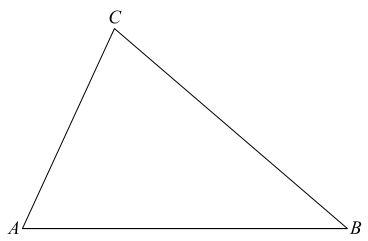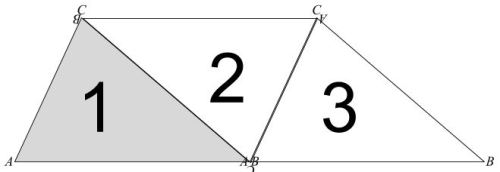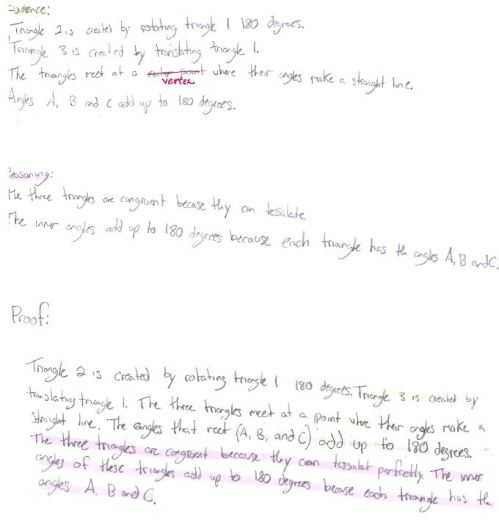Last year I used the process of Claim-Evidence-Reasoning, or CER, to teach statistics. I wrote about it a lot. I mean a lot. Seriously. More than I’ve written about anything else. (two more posts here & here.) But that was about teaching statistics. This term I have a geometry class and as my students were struggling with a proof, I had an “aha!” moment. Why not use the claim-evidence-reasoning process?
We were trying to prove why the sum of the interior angles of a triangle equals 180 degrees. Here’s what I gave them to start with.
That’s right. I just gave them a triangle. The traditional way to approach this proof is to draw a line through point C so that it’s parallel to side AB. And I did include that on the back, in case kids got stuck. But here’s the interesting thing – faced with just the triangle and a background of transformational geometry, they began rotating this triangle to tessellate a line of three triangles. It looked like this:

Then I asked kids to think about this approach, talk about it with each other, and then write a proof for why the sum of the interior angles of a triangle equals 180 degrees.
I collected what everyone had written and, like before, transcribed it for students to analyze for evidence and reasoning. Then we reviewed as a class to try to sort out the evidence (highlighted in cyan) from the reasoning (highlighted in orange). From there, I was able to give them another try with some direction from our conversation about evidence and reasoning. This was more successful. I pulled 4 examples to share with the class – I could have easily shared twice that number, which was more than half of the papers that I received from the class of 22. Here’s one of the 4 examples:

Unfortunately, what you can’t seen in this scan is how the individual statements are numbered. Thinking doesn’t always come in deductive order. Sometimes you just have to write down what you know and why you know it. Then you can go back and organize it. It’s like making a rough draft of the proof.
Today, as we were reviewing these exemplars, I asked my students how often they wrote rough drafts for their humanities essays (all the time) or how often they wrote rough drafts of their science CER (claim-evidence-reasoning) papers (all the time). So, it shouldn’t be surprising that a rough draft might be in order for a geometry proof.


Thanks for sharing. Our school also uses CER in the other subjects and I thought I’d try it with geometry too. I like your idea of drafts and letting students perfect and clarify their thinking. So far the most difficult part is getting students to the final reasoning.
I completely agree. I think the process helps kids organize their thinking, although getting them to the writing stage is still elusive. I was satisfied if my geometry students got to the verbal, telling, stage.